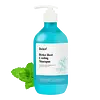What's inside
What's inside
 Key Ingredients
Key Ingredients

 Benefits
Benefits

 Concerns
Concerns

 Ingredients Side-by-side
Ingredients Side-by-side

Water
Skin ConditioningCocamidopropyl Betaine
CleansingSodium C14-16 Olefin Sulfonate
CleansingLauryl Glucoside
CleansingStearyl Citrate
EmollientGlycerin
HumectantPanthenol
Skin ConditioningRosmarinus Officinalis Leaf Oil
MaskingHydrolyzed Soy Protein
HumectantSambucus Nigra Fruit Extract
AstringentSalix Alba Bark Extract
AstringentTilia Cordata Flower Extract
Skin ConditioningVitis Vinifera Seed Extract
AntimicrobialMelilotus Officinalis Extract
AstringentMenthol
MaskingSpirulina Maxima Extract
SmoothingMentha Piperita Oil
MaskingGuar Hydroxypropyltrimonium Chloride
Skin ConditioningEthylhexylglycerin
Skin ConditioningPotassium Sorbate
PreservativeSodium Benzoate
MaskingParfum
MaskingWater, Cocamidopropyl Betaine, Sodium C14-16 Olefin Sulfonate, Lauryl Glucoside, Stearyl Citrate, Glycerin, Panthenol, Rosmarinus Officinalis Leaf Oil, Hydrolyzed Soy Protein, Sambucus Nigra Fruit Extract, Salix Alba Bark Extract, Tilia Cordata Flower Extract, Vitis Vinifera Seed Extract, Melilotus Officinalis Extract, Menthol, Spirulina Maxima Extract, Mentha Piperita Oil, Guar Hydroxypropyltrimonium Chloride, Ethylhexylglycerin, Potassium Sorbate, Sodium Benzoate, Parfum
Water
Skin ConditioningDisodium Laureth Sulfosuccinate
CleansingLauryl Betaine
CleansingCocamide Mipa
EmulsifyingSodium Cocoyl Alaninate
Sodium Cocoyl Isethionate
CleansingC12-13 Pareth-9
EmulsifyingSodium Chloride
MaskingMenthol
MaskingLauryl Glucoside
CleansingMentha Arvensis Leaf Oil
MaskingDipropylene Glycol
Humectant1,2-Hexanediol
Skin ConditioningCitric Acid
BufferingHydroxyacetophenone
AntioxidantPanthenol
Skin ConditioningSalicylic Acid
MaskingPolyquaternium-10
Niacinamide
SmoothingTetrasodium EDTA
Mentha Suaveolens Leaf Extract
AstringentButylene Glycol
HumectantMelaleuca Alternifolia Leaf Water
AntimicrobialPropanediol
SolventPrunus Mume Fruit Extract
HumectantMalus Domestica Fruit Extract
AntioxidantCarica Papaya Fruit Extract
Skin ConditioningVitis Vinifera Fruit Extract
Skin ConditioningCyclodextrin
AbsorbentHydrolyzed Vegetable Protein
Skin ConditioningCamellia Sinensis Leaf Extract
AntimicrobialMaltodextrin
AbsorbentPentylene Glycol
Skin ConditioningThymus Vulgaris Leaf Extract
Skin ProtectingEthylhexylglycerin
Skin ConditioningCaprylyl Glycol
EmollientMadecassoside
AntioxidantHydrolyzed Soy Protein Extract
Skin ConditioningLimonene
PerfumingWater, Disodium Laureth Sulfosuccinate, Lauryl Betaine, Cocamide Mipa, Sodium Cocoyl Alaninate, Sodium Cocoyl Isethionate, C12-13 Pareth-9, Sodium Chloride, Menthol, Lauryl Glucoside, Mentha Arvensis Leaf Oil, Dipropylene Glycol, 1,2-Hexanediol, Citric Acid, Hydroxyacetophenone, Panthenol, Salicylic Acid, Polyquaternium-10, Niacinamide, Tetrasodium EDTA, Mentha Suaveolens Leaf Extract, Butylene Glycol, Melaleuca Alternifolia Leaf Water, Propanediol, Prunus Mume Fruit Extract, Malus Domestica Fruit Extract, Carica Papaya Fruit Extract, Vitis Vinifera Fruit Extract, Cyclodextrin, Hydrolyzed Vegetable Protein, Camellia Sinensis Leaf Extract, Maltodextrin, Pentylene Glycol, Thymus Vulgaris Leaf Extract, Ethylhexylglycerin, Caprylyl Glycol, Madecassoside, Hydrolyzed Soy Protein Extract, Limonene
 Reviews
Reviews

Ingredients Explained
These ingredients are found in both products.
Ingredients higher up in an ingredient list are typically present in a larger amount.
Ethylhexylglycerin (we can't pronounce this either) is commonly used as a preservative and skin softener. It is derived from glyceryl.
You might see Ethylhexylglycerin often paired with other preservatives such as phenoxyethanol. Ethylhexylglycerin has been found to increase the effectiveness of these other preservatives.
Lauryl Glucoside sugar- and lipid-based cleansing agent. It is created from glucose and lauryl alcohol.
This ingredient is a surfactant, making it easier to rinse oil, dirt, and other pollutants away.
A British study found lauryl glucoside to cause skin sensitivity for some people. We recommend speaking with a professional if you have concerns.
Other names for this ingredient include "Lauryl Polyglucose", "Lauryl glycoside", and "D-Glucopyranoside".
Learn more about Lauryl GlucosideMenthol is a compound found in mint plants, such as peppermint. In its pure form, it is a clear crystalline substance.
Menthol is known for its cooling sensation; however, the cooling is actually from your skin being sensitized. Menthol can worsen rosacea. We recommend speaking with a professional if you have concerns.
Menthol also has antimicrobial properties.
Learn more about MentholPanthenol is a common ingredient that helps hydrate and soothe the skin. It is found naturally in our skin and hair.
There are two forms of panthenol: D and L.
D-panthenol is also known as dexpanthenol. Most cosmetics use dexpanthenol or a mixture of D and L-panthenol.
Panthenol is famous due to its ability to go deeper into the skin's layers. Using this ingredient has numerous pros (and no cons):
Like hyaluronic acid, panthenol is a humectant. Humectants are able to bind and hold large amounts of water to keep skin hydrated.
This ingredient works well for wound healing. It works by increasing tissue in the wound and helps close open wounds.
Once oxidized, panthenol converts to pantothenic acid. Panthothenic acid is found in all living cells.
This ingredient is also referred to as pro-vitamin B5.
Learn more about PanthenolWater. It's the most common cosmetic ingredient of all. You'll usually see it at the top of ingredient lists, meaning that it makes up the largest part of the product.
So why is it so popular? Water most often acts as a solvent - this means that it helps dissolve other ingredients into the formulation.
You'll also recognize water as that liquid we all need to stay alive. If you see this, drink a glass of water. Stay hydrated!
Learn more about Water